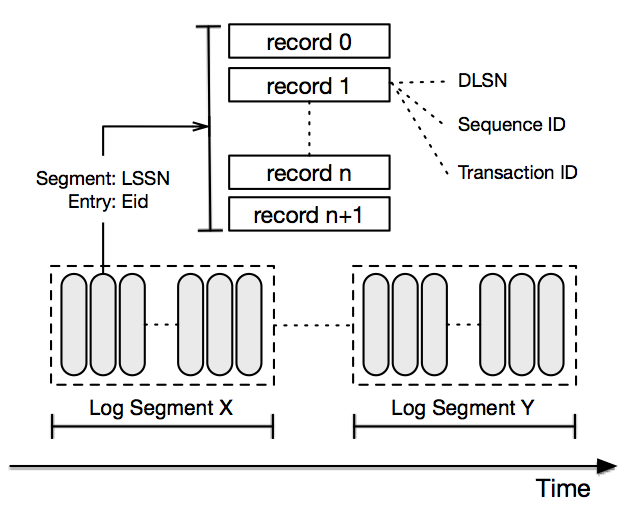Introduction¶
DistributedLog (DL) is a high performance replicated log service. It offers durability, replication and strong consistency, which provides a fundamental building block for building reliable distributed systems, e.g replicated-state-machines, general pub/sub systems, distributed databases, distributed queues and etc.
DistributedLog maintains sequences of records in categories called Logs (aka Log Streams). The processes that write records to a DL log are writers, while the processes that read from logs and process the records are readers.

Figure 1. DistributedLog Software Stack
Logs¶
A log is an ordered, immutable sequence of log records.

Figure 2. Anatomy of a log stream
Log Records¶
Each log record is a sequence of bytes. Log records are written sequentially into a log stream, and will be assigned with a unique sequence number called DLSN (DistributedLog Sequence Number). Besides DLSN, applications could assign its own sequence number while constructing log records. The application defined sequence number is called TransactionID (txid). Either DLSN or TransactionID could be used for positioning readers to start reading from a specific log record.
Log Segments¶
A log is broken down into segments, which each log segment contains its subset of records. Log segments are distributed and stored in a log segment store (e.g Apache BookKeeper). DistributedLog rolls the log segments based on configured rolling policy - either a configurable period of time (e.g. every 2 hours) or a configurable maximum size (e.g. every 128MB). So the data of logs will be divided into equal-sized log segments and distributed evenly across log segment storage nodes. It allows the log to scale beyond a size that will fit on a single server and also spread read traffic among the cluster.
The data of logs will either be kept forever until application explicitly truncates or be retained for a configurable period of time. Explicit Truncation is useful for building replicated state machines such as distributed databases. They usually require strong controls over when the data could be truncated. Time-based Retention is useful for real-time analytics. They only care about the data within a period of time.
Namespaces¶
The log streams belong to same organization are usually categorized and managed under a namespace. A DL namespace is basically for applications to locate where the log streams are. Applications could create and delete streams under a namespace, and also be able to truncate a stream to given sequence number (either DLSN or TransactionID).
Writers¶
Writers write data into the logs of their choice. All the records are appended into the logs in order. The sequencing is done by the writer, which means there is only one active writer for a log at a given time. DL guarantees correctness when two writers attempt writing to to a same log when network partition happens - via fencing mechanism in log segment store.
The log writers are served and managed in a service tier called Write Proxy. The Write Proxy is used for accepting fan-in writes from large number of clients. Details on Fan-in and Fan-out can be found further into this doc.
Readers¶
Readers read records from the logs of their choice, starting from a provided position. The provided position could be either DLSN or TransactionID. The readers will read records in strict order from the logs. Different readers could read records starting from different positions in a same log.
Unlike other pub/sub systems, DistributedLog doesn't record/manage readers' positions. It leaves the tracking responsibility to applications, as different applications might have different requirements on tracking and coordinating positions. It is hard to get it right with a single approach. For example, distributed databases might store the reader positions along with SSTables, so they would resume applying transactions from the positions stored in SSTables. Tracking reader positions could easily be done in application level using various stores (e.g. ZooKeeper, FileSystem, or Key/Value Stores).
The log records could be cached in a service tier called Read Proxy, to serve large number of readers. Details on Fan-in and Fan-out can be found further into this doc.
Fan-in and Fan-out¶
The core of DistributedLog supports single-writer, multiple-readers semantics. The service layer built on top of the DistributedLog Core to support large scale of number of writers and readers. The service layer includes Write Proxy and Read Proxy. Write Proxy manages the writers of logs and fail over them when machines are failed. It allows supporting which don't care about the log ownership by aggregating writes from many sources (aka Fan-in). Read Proxy optimize reader path by caching log records in cases where hundreds or thousands of readers are consuming a same log stream.
Guarantees¶
At a high-level, DistributedLog gives the following guarantees:
- Records written by a writer to a log will be appended in the order they are written. That is, if a record R1 is written by same writer as a record R2, R1 will have a smaller sequence number than R2.
- Readers will see records in same order they were written to the log.
- All records were persisted on disks before acknowledges, to gurantee durability.
- For a log with replication factor of N, DistributedLog tolerates up to N-1 server failures without losing any records appended to the log.
More details on these guarantees are given in the design section of this documentation.